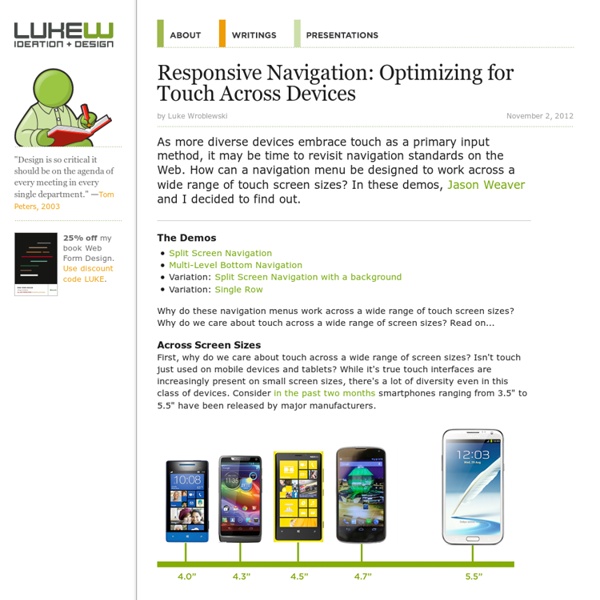Responsive Navigation: Optimizing for Touch Across Devices

Implementing Off-Canvas Navigation For A Responsive Website
Responsive WordPress Menu Plugin for Mobile Devices
The Responsive Select Menu plugin lets you automatically turn your “WordPress 3 Menus” into an easy-to-scroll select box/dropdown menu. (A “WordPress 3 Menu” is a menu created through the WordPress admin area: Appearance > Menus. Many people typically use these menus in their top navigation spot, as well as other places.) The Plugin in Action Let’s go ahead and jump right into some examples to show you what it looks like. Here’s a look at a normal top menu in a mobile device using the WordPress Twenty Ten theme. And now here’s a look at that same top menu with the Responsive Select Menu plugin activated. When you touch the menu and pull it down, you get a select box/dropdown menu that you can easily scroll through with your finger. Featured Plugin - WordPress Newsletter Plugin Now there's no need to pay for a third party service to sign up, manage and send beautiful email newsletters to your subscriber base - this plugin has got the lot. Find out more Settings Width Breakpoint See a Working Demo
Responsive Menu Concepts
The following is a guest post by Tim Pietrusky. I know Tim from his prolific work on CodePen and from being a helpful community member there. He wrote to me with this guest post about responsive menus which I'm more than happy to share with you below. When it comes to responsive design we are faced with various techniques on how to best handle altering our navigation menus for small screens. Three of them are made with pure CSS and one uses a single line of JavaScript. Before We Start In the code presented in this article, I don’t use any vendor-prefixes to keep the CSS easier to see and understand. All menu concepts in this article are based on this simple HTML structure which I call basic menu. <nav role=""><ul><li><a href="#">Stream</a></li><li><a href="#">Lab</a></li><li><a href="#">Projects</a></li><li><a href="#">About</a></li><li><a href="#">Contact</a></li></ul></nav> To address small screens I use the same media query on all concepts. @media screen and (max-width: 44em) { } 1. 2.
Related:
Related:



